Analysis of the Ecosystem Soil Conservation Function Based on the Major Function-Oriented Zones across the Yangtze River Economic Belt, China
Abstract
:1. Introduction
2. Materials and Methods
2.1. Study Area
2.2. Methods
2.2.1. Land Use Dynamics
2.2.2. Soil Conservation Assessment
Rainfall Erodibility Factor (R)
Soil Erodibility Factor (K)
Topographic Factor (LS)
Vegetation Cover Factor (C)
Erosion Control Practice Factor (P)
2.2.3. Change Trend Analysis
2.3. Data Sources
2.3.1. Land Use Datasets
2.3.2. Major Function-Oriented Zones
2.3.3. Other Data
3. Results
3.1. Analysis and Changes in Land Use
3.1.1. Land Use Analysis in 2015
3.1.2. Land Use Changes between 2010 and 2015
3.2. Analysis and Changes in the Soil Conservation Function
3.2.1. Analysis of the Soil Retention in the YREB
3.2.2. Spatial and Temporal Characteristics for the Soil Retention Rate
4. Discussion
4.1. Matching or Not towards Functional Orientation of the MFOZs
4.2. Strengths, Weaknesses and Future Research of This Analysis
5. Conclusions
Author Contributions
Funding
Acknowledgments
Conflicts of Interest
References
- Mao, J.; Yan, X.; Wang, A.; Li, X.; Qian, Z. A review and prospect of studies on the intensified urban land use in China since 1990s. Geogr. Geo-Inf. Sci. 2005, 21, 48–52. [Google Scholar]
- Deng, X.; Huang, J.; Rozelle, S.; Uchida, E. Growth, population and industrialization, and urban land expansion of China. J. Urban Econ. 2008, 63, 96–115. [Google Scholar] [CrossRef]
- Liu, J.; Kuang, W.; Zhang, Z.; Xu, X.; Qin, Y.; Ning, J.; Zhou, W.; Zhang, S.; Li, R. Spatiotemporal characteristics, patterns and causes of land use changes in China since the late 1980s. J. Geogr. Sci. 2014, 69, 3–14. [Google Scholar] [CrossRef]
- Bo, W.; An, H.; Li, J. Construction of Major Functional Zones and Chinese regional coordinated development, promotive or aggressive. China Pop Res. Environ. 2011, 21, 121–128. [Google Scholar]
- Fan, J. Draft of major function oriented zoning of China. J. Geogr. Sci. 2015, 70, 186–201. [Google Scholar]
- Fan, J.; Sun, W.; Zhou, K.; Chen, D. Major Function Oriented Zone: New method of spatial regulation for reshaping regional development pattern in China. J. Geogr. Sci. 2012, 22, 196–209. [Google Scholar] [CrossRef]
- Fan, J. The strategy of Major Function Oriented Zoning and the optimization of territorial development patterns. Bull. CAS 2013, 28, 193–206. [Google Scholar]
- Wan, X.; Yu, R.; Yu, X.; Luo, J. Research of monitoring and assessment of major function oriented zoning plan implementing based on the geological condition survey. Res. Environ. Yangtze Basin 2015, 24, 358–363. [Google Scholar]
- Wu, Q.; Zhao, H. Basic laws of soil and water conservation by vegetation and its summation. J. Soil Water Conserv. 2001, 15, 13–15. [Google Scholar]
- Zhao, H.; Wu, Q.; Liu, G. Studies on soil and water conservation functions of litter in Chinese Pine Stand on Loess Plateau. For. Sci. 2003, 39, 168–172. [Google Scholar]
- Daily, G.C.; Polasky, S.; Goldstein, J.; Kareiva, P.M.; Mooney, H.A.; Pejchar, L.; Ricketts, T.H.; Salzman, J.; Shallenberger, R. Ecosystem services in decision making: Time to deliver. Front. Ecol. Environ. 2009, 7, 21–28. [Google Scholar] [CrossRef]
- Zheng, H.; Li, Y.; Ouyang, Z.; Luo, Y. Progress and perspectives of ecosystem services management. J. Ecol. Sci. 2013, 33, 702–710. [Google Scholar]
- Keesstra, S.; Nunes, J.P.; Novara, A.; Finger, D.; Avelar, D.; Kalantari, Z.; Cerdà, A. The superior effect of nature based solutions in land management for enhancing ecosystem services. Sci. Total Environ. 2018, 610, 997–1009. [Google Scholar] [CrossRef] [PubMed] [Green Version]
- Sun, W.; Shao, Q.; Liu, J. Assessment of soil conservation function of the ecosystem services on the Loess Plateau. J. Nat. Res. 2014, 29, 365–376. [Google Scholar]
- Liu, J.; Jin, T.; Liu, G.; Li, Z.; Y, J. Changes in land use and soil and water conservation of the upper and middle reaches of Heihe river basin during 2000–2010. J. Ecol. Sci. 2014, 34, 7013–7025. [Google Scholar]
- Wischmeier, W.H.; Smith, D.D. Predicting Rainfall Erosion Losses A Guide to Conservation Planning; U.S. Government Printing Office: Washington, DC, USA, 1978; Volume 537.
- Harden, C.P. Soil erosion and sustainable mountain development. Mt. Res. Dev. 2001, 34, 77–83. [Google Scholar] [CrossRef]
- Zhao, T.Q.; Yang, B.S.; Zheng, H. Assessment of the erosion control function of forest ecosystems based on GIS: A case study in Zhangjiajie National Forest Park, China. Int. J. Sustain. Dev. World Ecol. 2009, 16, 356–361. [Google Scholar] [CrossRef]
- Yang, D.; Kanae, S.; Oki, T.; Koike, T.; Musiake, K. Global potential soil erosion with reference to land use and climate changes. Hydrol. Process. 2010, 17, 2913–2928. [Google Scholar] [CrossRef]
- Rao, E.M.; Ouyang, Z.Y.; Yu, X.X.; Xiao, Y. Spatial patterns and impacts of soil conservation service in China. Geomorphology 2014, 207, 64–70. [Google Scholar] [CrossRef]
- Fu, B.J.; Wang, Y.F.; Lü, Y.H.; He, C.S.; Chen, L.D.; Song, C.J. The effects of land-use combinations on soil erosion: A case study in the Loess Plateau of China. Prog. Phys. Geogr. 2009, 33, 793–804. [Google Scholar] [CrossRef]
- Fu, B.J.; Wang, S.; Su, C.H.; Forsius, M. Linking ecosystem processes and ecosystem services. Curr. Opin. Environ. Sustain. 2013, 5, 4–10. [Google Scholar] [CrossRef]
- Xie, S.H.; Zeng, J.L.; Yang, J.; Yuan, F. Effects of different tillage measures on soil and water conservation in slope farmland of red soil in Southern China. Trans. Agric. Eng. 2010, 26, 81–86. [Google Scholar]
- Xu, X.H.; Sui, Y.Y.; Zhang, Y.; Wang, Y.F.; Liu, M.Y.; Liu, Y.J. Effects of different tillages on the soil and water conservation benefits in Northeast black soil area of China. Soil Water Conserv. 2013, 11, 12–16. [Google Scholar]
- Sultan, D.; Tsunekawa, A.; Haregeweyn, N.; Adgo, E.; Tsubo, M.; Meshesha, D.T. Impact of soil and water conservation interventions on watershed runoff response in a tropical humid highland of Ethiopia. Environ. Manag. 2018, 61, 1–15. [Google Scholar] [CrossRef] [PubMed]
- Lü, Y.H.; Fu, B.J.; Feng, X.M.; Zeng, Y.; Liu, Y.; Chang, R.Y.; Sun, G.; Wu, B.F. A policy-driven large scale ecological restoration: Quantifying ecosystem services changes in the Loess Plateau of China. PLoS ONE. 2012, 7, e31782. [Google Scholar] [CrossRef] [PubMed]
- Dodds, W.K.; Perkin, J.S.; Gerken, J.E. Human impact on freshwater ecosystem services: A global perspective. Environ. Sci. Technol. 2013, 47, 9061–9068. [Google Scholar] [CrossRef] [PubMed]
- Zhang, S.; Fan, W.; Li, Y.; Yi, Y. The influence of changes in land use and landscape patterns on soil erosion in a watershed. Sci. Total Environ. 2017, 574, 34–45. [Google Scholar] [CrossRef] [PubMed]
- Tang, C.; Sun, W. Comprehensive evaluation of land spatial development suitability of the Yangtze River Basin. J. Geogr. Sci. 2012, 67, 1587–1598. [Google Scholar]
- Cen, X.; Zhou, Y.; Shan, W.; Teng, Y.; Li, F. The resources and environment pattern and sustainable development of Yangtze River Economic Zone. China Dev. 2015, 15, 1–9. [Google Scholar]
- Yang, G.; Xu, X.; Li, P. Research on the construction of green ecological corridors in the Yangtze River Economic Belt. Prog. Geogr. 2015, 34, 1356–1367. [Google Scholar]
- Tang, Q.; He, C.S.; He, X.B.; Bao, Y.H.; Zhong, R.H.; Wen, A.B. Farmers’ Sustainable Strategies for Soil Conservation on, Sloping Arable Lands in the Upper Yangtze River Basin, China. Sustainability 2014, 6, 4795–4806. [Google Scholar] [CrossRef]
- Liu, Y.M.; Chen, Y.M.; Hu, Y.C. Spatial-temporal distribution characteristics of soil conservation ability in Yangtze Basin. Res. Environ. Yangtze Basin 2015, 24, 971–977. [Google Scholar]
- Kong, L.Q.; Zheng, H.; Rao, E.M.; Xiao, Y.; Ouyang, Z.Y.; Li, C. Evaluating indirect and direct effects of eco-restoration policy on soil conservation service in Yangtze River Basin. Sci. Total Environ. 2018, 631, 887–894. [Google Scholar] [CrossRef] [PubMed]
- Jiang, C.; Zhang, L. Ecosystem change assessment in the Three-river Headwater Region, China: Patterns, causes, and implications. Ecol. Eng. 2016, 93, 24–36. [Google Scholar] [CrossRef]
- Renard, K.G.; Foser, G.R.; Weesies, G.A.; Mccool, D.K.; Yoder, D.C. Predicting Soil Erosion by Water: A Guide to Conservation Planning with the Revised Universal Soil Loss Equation (RUSLE); United States Department of Agriculture: Washington, DC, USA, 1997; Volume 703.
- Zhang, W.; Xie, Y.; Liu, B. Rainfall Erosivity Estimation using daily rainfall amounts. Geogr. Sci. 2002, 22, 705–711. [Google Scholar]
- Fan, J.; He, H.; Guo, B. Temporal and spatial variations of rainfall erosivity in Yellow River from 1980 to 2015. J. Geo-Inf. Sci. 2018, 20, 196–204. [Google Scholar]
- Xie, Y.; Liu, B.; Zhang, W. Study on standard of erosive rainfall. J. Soil Water Conserv. 2000, 14, 6–11. [Google Scholar]
- Wischmeier, W.H.; Johnson, C.B.; Cross, B.V. Soil erodibility nomograph for farmland and construction sites. J. Soil Water Conserv. 1971, 26, 189–193. [Google Scholar]
- Williams, J.R.; Jones, C.A.; Dyke, P.T. A modeling approach to DetemliDiDg d1e relationship between erosion and soil productivity. Trans. ASABE 1984, 27, 129–144. [Google Scholar] [CrossRef]
- Lu, D.; Li, G.; Valladares, G.S.; Batistella, M. Mapping soil erosion risk in Rondônia, Brazilian Amazonia: Using RUSLE, remote sensing and GIS. Land Degrad. Dev. 2004, 15, 499–512. [Google Scholar] [CrossRef] [Green Version]
- Mccool, D.K.; Foster, G.R.; Mutchler, C.K.; Mutchler, C.K.; Meyer, L.D. Revised slope length factor for the universal soil loss equation. Trans. ASABE 1989, 30, 1387–1396. [Google Scholar] [CrossRef]
- Liu, B.; Nearing, M.; Shi, P.; Jia, Z. Slope length effects on soil loss for steep slopes. Soil Sci. Soc. Am. J. 1994, 64, 1759–1763. [Google Scholar] [CrossRef]
- Wang, H.; Liu, G. Analyses on vegetation structures and their controlling soil erosion. J. Arid Land Environ. 1999, 13, 62–68. [Google Scholar]
- Cai, C. Study of applying USLE and Geographical Information System IDRISI to predict soil erosion in small watershed. J. Soil Water Conserv. 2000, 14, 19–24. [Google Scholar]
- Li, Z.; Zhang, Y.; Zhu, Q.; Yao, W. Assessment of bank gully development and vegetation coverage on the Chinese Loess Plateau. Geomorphology 2015, 228, 462–469. [Google Scholar] [CrossRef]
- DB 63/T. Technical specification of effect assessment on ecological protection and construction in the Three-River Headwaters Region. 2014. Available online: http://www.wanfangdata.com.cn/details/detail.do?_type=techResult&id=1600440487 (accessed on 15 March 2015).
- Liu, J.H.; Gao, J.X.; Wang, W.J. Variations of vegetation coverage and its relations to global climate changes on the Tibetan Plateau during 1981–2005. J. Mt. Sci. Engl. 2013, 27, 113–120. [Google Scholar]
- Liu, J.; Liu, M.; Tian, H.; Zhuang, D.; Zhang, Z.; Zhang, W.; Tang, X.M.; Deng, X.Z. Spatial and temporal patterns of China’s cropland during 1990–2000: An analysis based on Landsat TM data. Remote Sens. Environ. 2005, 98, 442–456. [Google Scholar] [CrossRef]
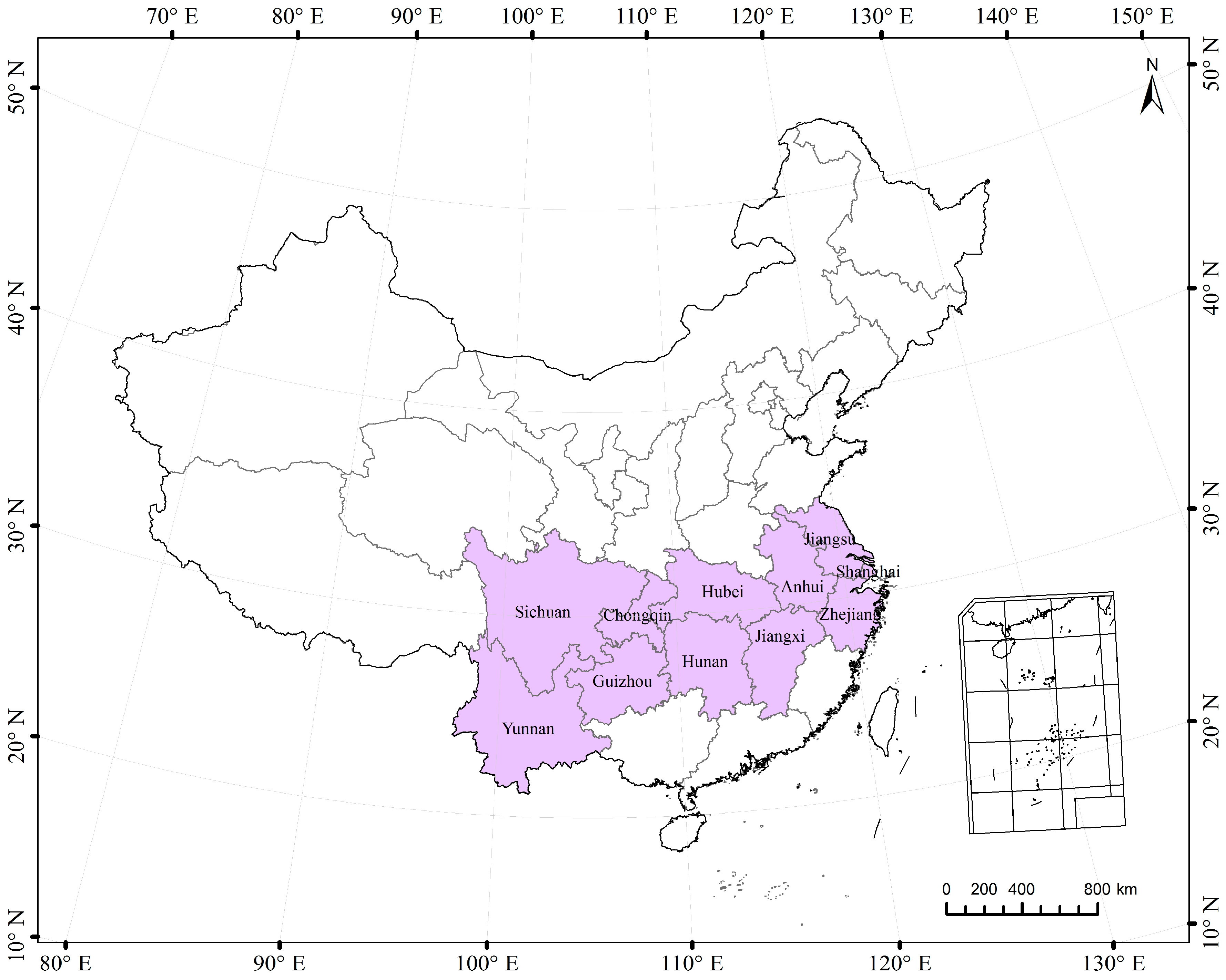

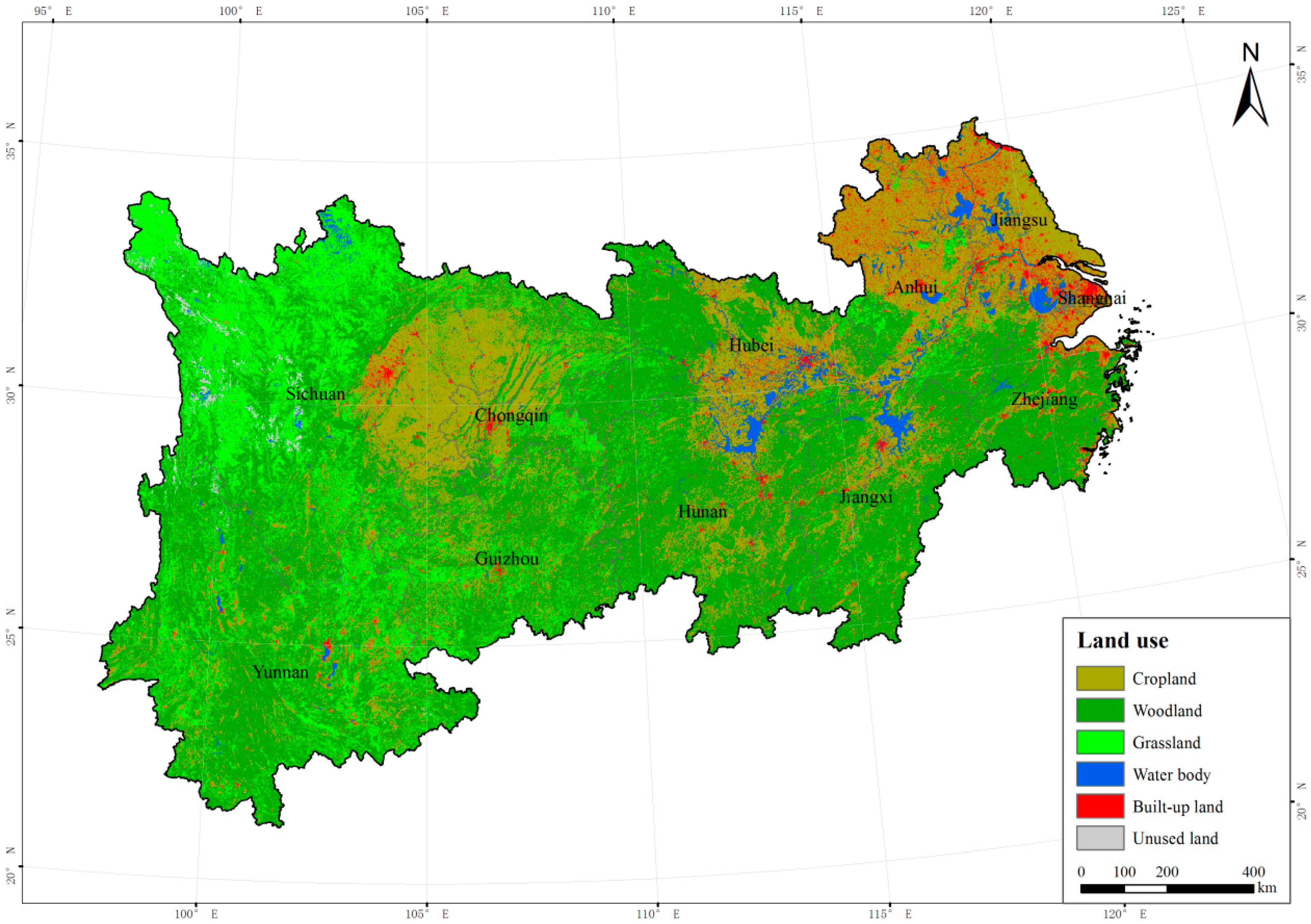
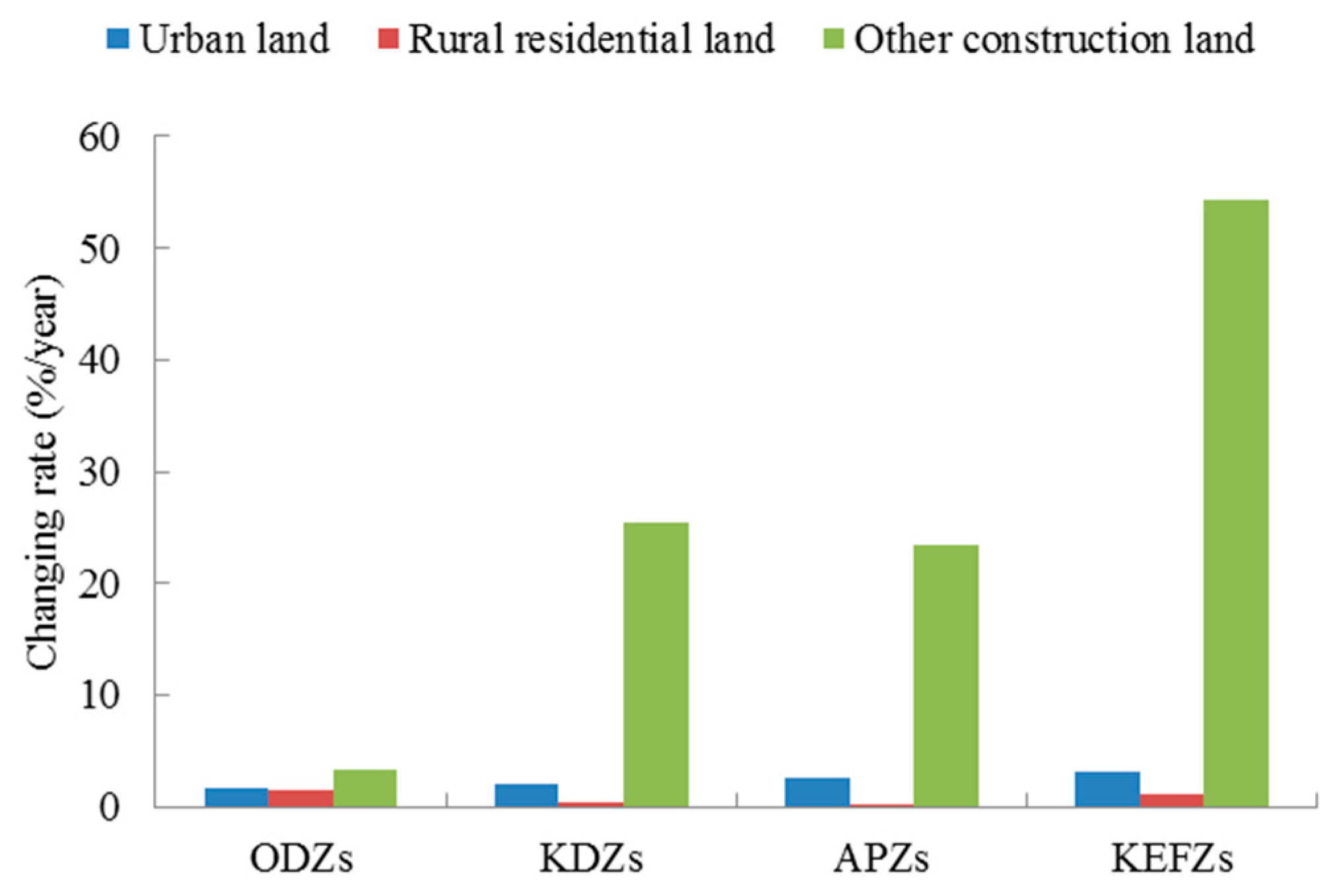
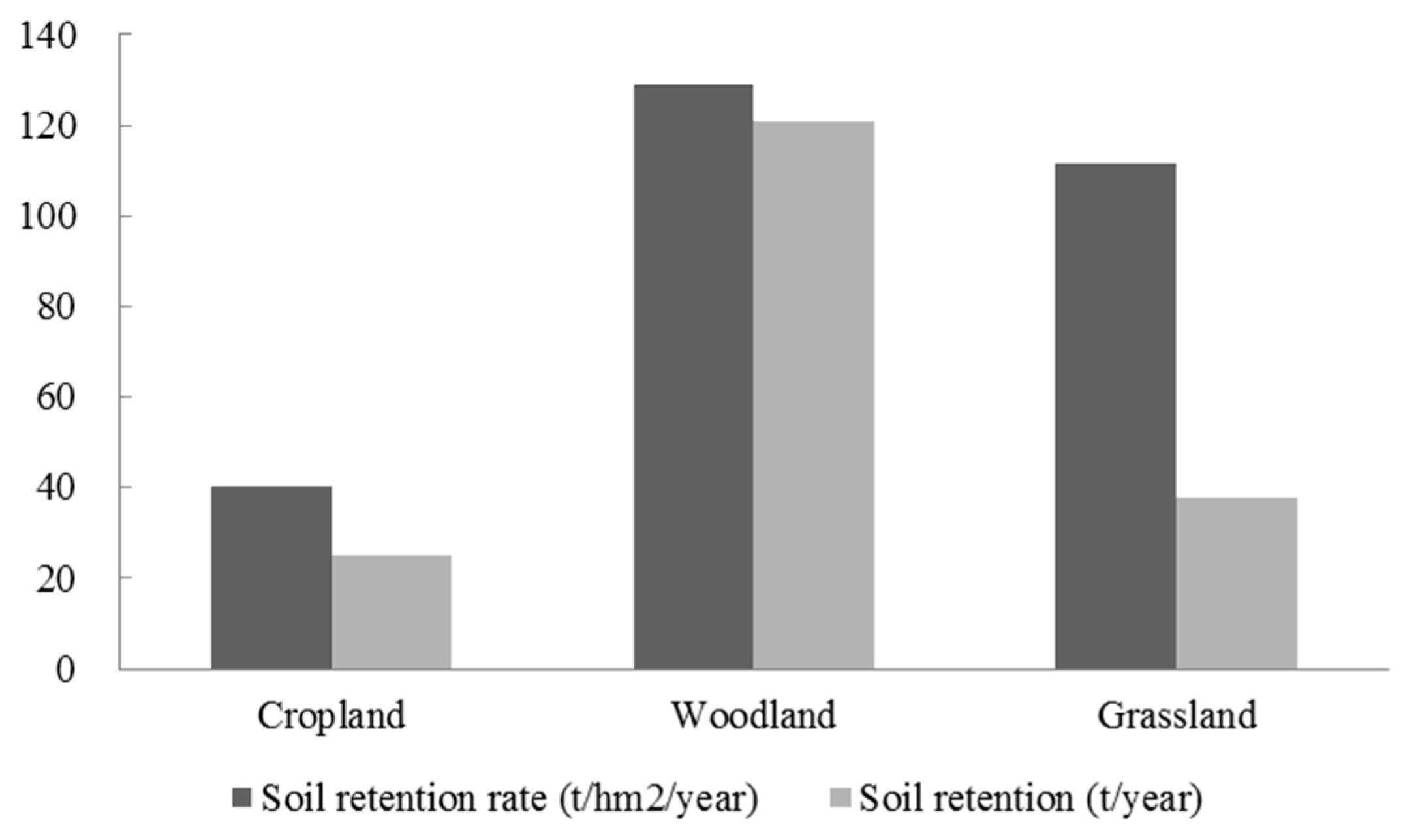

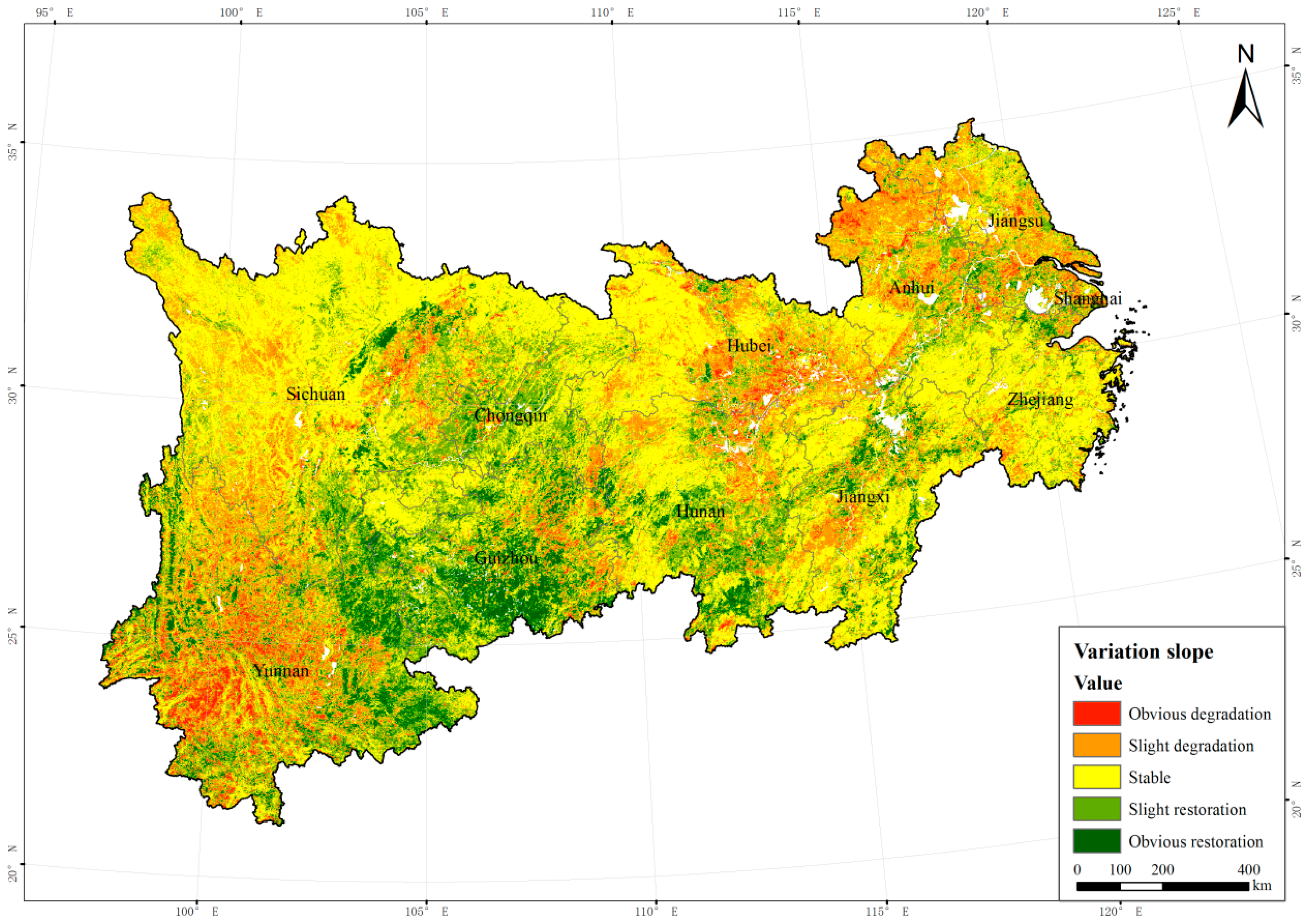
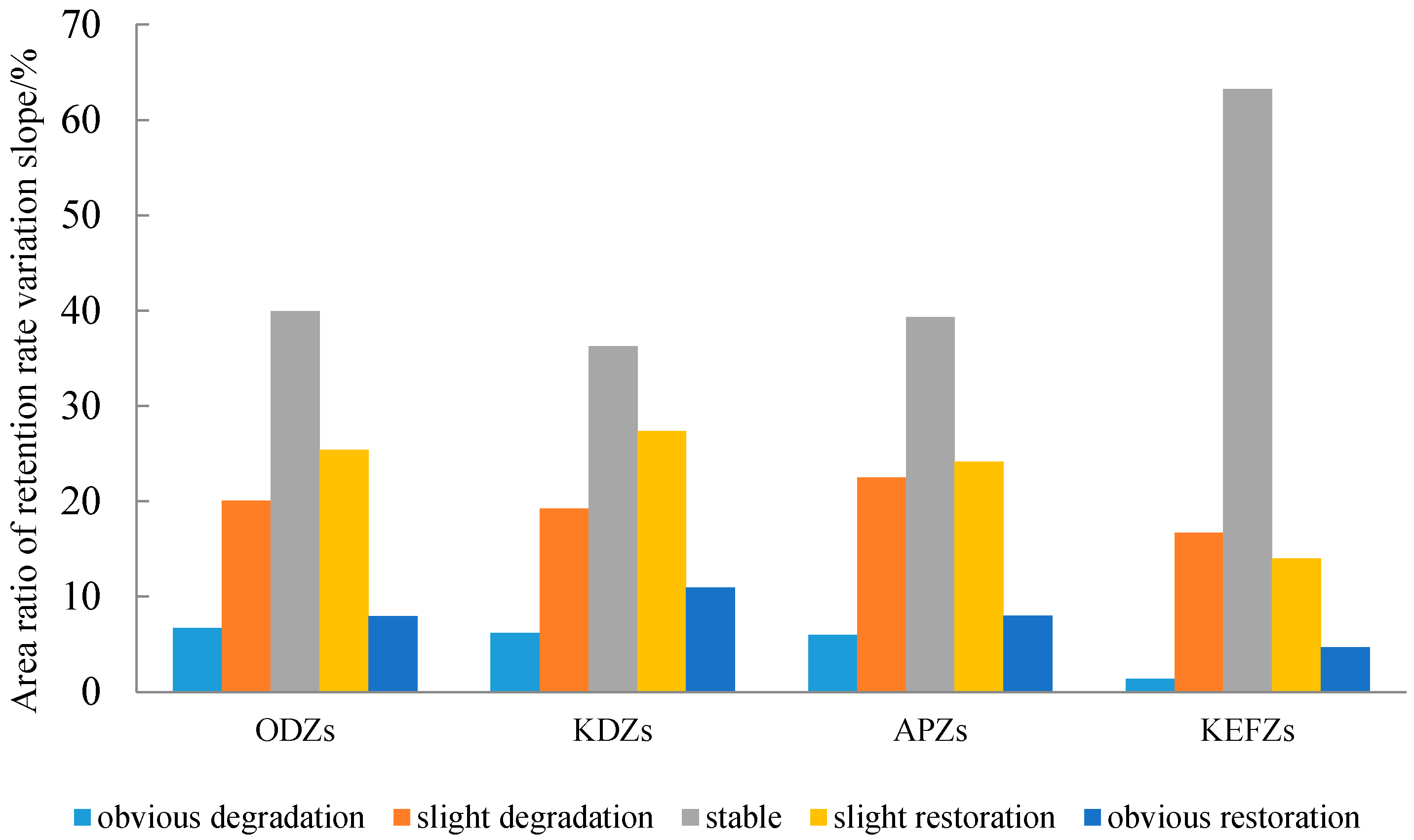
| Land Use | Woodland | Grassland | Cropland | Others | |||
|---|---|---|---|---|---|---|---|
| Flat | Hills | Mountainous | Steep Slope (>25°) | ||||
| p value | 1 | 1 | 0.20 | 0.35 | 0.65 | 0.80 | 1 |
| First-Level Classes | Second-Level Classes |
|---|---|
| Woodland | Forest, Shrub, Woods, Others |
| Grassland | Dense grass, Moderate grass, Sparse grass |
| Cropland | Paddy land, Dry land |
| Water body | Stream and rivers, Reservoir and ponds, Lakes, Permanent ice and snow, Bottomland, Beach and shore |
| Built-up land | Urban land, Rural residential land, Other construction land |
| Unused land | Sandy land, Gobi, Salina, Swampland, Bare soil, Bare rock, Others |
| Types | Major Function | Description | |
|---|---|---|---|
| Optimal development zones | Massive urbanization and industrialization | Areas with high development density and population density | |
| Key development zones | Areas with great development potential for industrialization and urbanization | ||
| Restricted development zones | Agricultural production zones | Providing of agricultural products | Mainly including the national major grain producing counties |
| Key ecological function zones | Providing of ecological products and services | Protecting crucial ecosystem functions and fragile ecological systems | |
| Prohibited development zones | Protection of natural and cultural heritage | Protected areas, such as national nature reserves, national forest parks, national scenic spots and national geological parks | |
| Zones | Area of Built-Up Area (×104 km2) | Proportion of Urban Land (%) | Proportion of Rural Residential Land (%) | Proportion of Other Construction Land (%) |
|---|---|---|---|---|
| Optimal development zones | 1.03 | 46.40 | 42.84 | 10.76 |
| Key development zones | 1.32 | 32.07 | 42.01 | 25.92 |
| Agricultural production zones | 2.31 | 14.24 | 73.74 | 12.02 |
| Key ecological function zones | 0.23 | 17.20 | 41.12 | 41.68 |
| Cropland | Woodland | Grassland | Water Body | Built-Up Land | Unused Land | |
|---|---|---|---|---|---|---|
| Optimal development zones (ODZs) | −0.78 | −0.09 | 2.02 | −0.01 | 1.75 | 0 |
| Key development zones (KDZs) | −0.38 | −0.12 | −0.10 | 0.10 | 4.14 | 2.21 |
| Agricultural production zones (APZs) | −0.13 | −0.06 | 0 | 0.32 | 1.89 | 0.41 |
| Key ecological function zones (KEFZs) | −0.14 | −0.02 | −0.01 | 0.42 | 9.85 | 0 |
| Classification | Variation of Soil Retention Rate during 2010 and 2015 | |
|---|---|---|
| Area (×104 km2) | Ratio (%) | |
| Obvious degradation | 8.65 | 4.22 |
| Slight degradation | 38.42 | 18.74 |
| Stable | 99.44 | 48.51 |
| Slight restoration | 43.95 | 21.44 |
| Obvious restoration | 14.54 | 7.09 |
© 2018 by the authors. Licensee MDPI, Basel, Switzerland. This article is an open access article distributed under the terms and conditions of the Creative Commons Attribution (CC BY) license (http://creativecommons.org/licenses/by/4.0/).
Share and Cite
Wu, D.; Zou, C.; Cao, W.; Liu, L. Analysis of the Ecosystem Soil Conservation Function Based on the Major Function-Oriented Zones across the Yangtze River Economic Belt, China. Sustainability 2018, 10, 3425. https://doi.org/10.3390/su10103425
Wu D, Zou C, Cao W, Liu L. Analysis of the Ecosystem Soil Conservation Function Based on the Major Function-Oriented Zones across the Yangtze River Economic Belt, China. Sustainability. 2018; 10(10):3425. https://doi.org/10.3390/su10103425
Chicago/Turabian StyleWu, Dan, Changxin Zou, Wei Cao, and Lulu Liu. 2018. "Analysis of the Ecosystem Soil Conservation Function Based on the Major Function-Oriented Zones across the Yangtze River Economic Belt, China" Sustainability 10, no. 10: 3425. https://doi.org/10.3390/su10103425
APA StyleWu, D., Zou, C., Cao, W., & Liu, L. (2018). Analysis of the Ecosystem Soil Conservation Function Based on the Major Function-Oriented Zones across the Yangtze River Economic Belt, China. Sustainability, 10(10), 3425. https://doi.org/10.3390/su10103425






